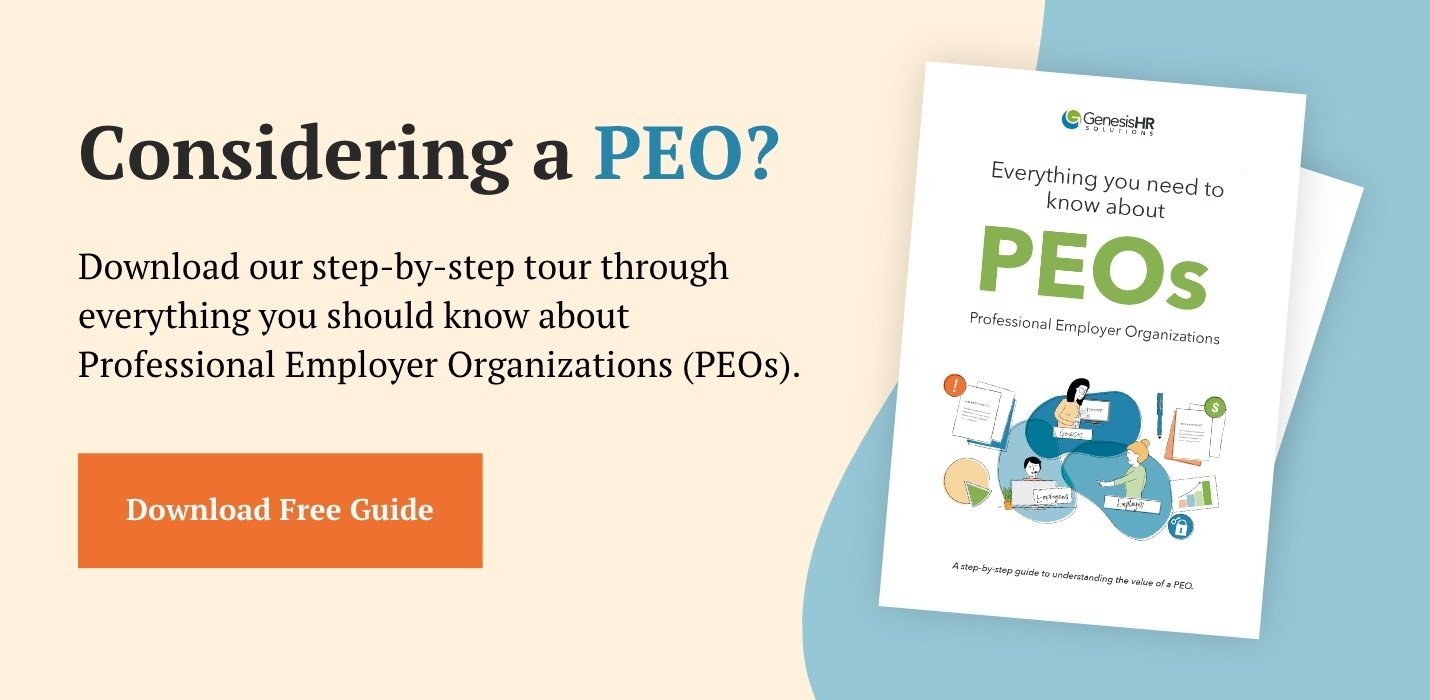New Year… new PEO? Maybe!
It’s common for small or midsize businesses to assess their partnerships at the beginning of a new year, either fiscal or calendar, to make sure they are still enjoying a mutually beneficial relationship. Hopefully you’ve started 2022 with lots of momentum, and are in a good position to evaluate all your partners, including your PEO.
If you haven’t finished—or started—your annual audit of partners, it’s not too late! Use this article to help determine if your current partner is still a good fit, or if you need to begin the process of switching PEOs.
Why would a company consider switching PEOs?
Typically, small and midsize business owners leave one PEO for another because the PEO’s services are no longer meeting the company’s needs. This is the most common issue we see—clients needing timely and accurate answers when they have questions and guidance when they need help.
Businesses may also leave their existing PEO as a result of increasing costs and/or changing benefits. The most important benefit to most of us is health insurance, which is also the most costly for businesses. Many PEOs change carriers and/or plans offered to mitigate annual premium increases. This approach can be disruptive to the business and more specifically to their employees.
Making the decision to consider leaving your PEO really comes down to a cost-benefit evaluation: Am I getting what I pay for?
8 Ways To Evaluate Your Current PEO
| 1. Are you getting what you pay for? What have you gained as a result of your PEO partnership? |
| 2. Does the service your PEO offers fit your company’s needs for this year (and beyond)? |
| 3. What costs are changing for the fiscal year? How will that affect you and your employees? |
| 4. Have any issues you’ve encountered with your PEO been quickly and satisfactorily resolved? |
| 5. Have you experienced any red flags in working with the PEO that have not been addressed? This may include errors in payroll, delays in responses, or lack of guidance on important HR matters. |
| 6. Do you enjoy interacting with the people in your PEO? What is your relationship like? |
| 7. Are you able to quickly and reliably communicate with your PEO? |
| 8. Are your employees able to quickly and reliably communicate with your PEO? |
PEOs are supporting your most valued asset: your people. If the service at your current PEO is not excellent, then it’s time to find a better fit. Your team deserves the right solution.
And believe it or not, switching from one PEO to another is easier than engaging a PEO for the first time. You already understand the value of working with a PEO and what the implementation process is like, so you’re not starting from scratch. It will almost certainly be faster to switch PEO providers than it was for your organization to start working with one originally.
Even a switch, however, takes some planning. Below are five steps to follow that will help you efficiently close out one relationship and begin another.
5 Steps To Switching PEOs (The Right Way)
1. Identify your needs and what isn’t working with your current PEO.
The questions in the chart above are a good starting point. Some other common things you may be noticing that indicate it’s time to consider other options are:
- You like the PEO model, but something is amiss with your current partner.
- Your expectations are not being met. If this is the case, clearly identify what needs to improve, and give the partner time to turn things around. If they can follow through on those improvements, you may not need to move!
Additionally, try to identify what the PEO did well—these are things you don’t want to lose if you were to make a switch. Altogether, these bullet points, as well as the chart listed above, become your PEO questionnaire/checklist as you evaluate prospects.
2. Gather information about PEOs you’re considering.
It’s important to do your homework on each PEO under consideration and be wary of standard sales responses to your inquiries. Here are specific things to look for as you gather information about other PEOs:
- What is their service approach? Do they have people who are willing and able to help your employees, who know your company and its nuances by heart? Will your employees have to call an 800-number every time they need help, or will they have a dedicated team at their service?
At GenesisHR, we pride ourselves on being available to you, the business owner, as well as your employees, whenever you need us. Our service team that supports your company’s owners and leaders are the same points of contact for your employees. There’s no call center, no client ID numbers or social security numbers—just call or email us, and we’ll know who you are. - What access to experts do you get? What are the qualifications of the service team, and how available are they? Will they guide you in compliance challenges and do they have experience in the states where you have employees? Our team brings many years of experience in their respective specialties: HR, benefits, payroll, and risk management. We hire the best and leverage their expertise to meet your needs, wherever that may take you.
- What technology do they offer? All PEOs have a tech platform, but not all tech platforms are created equally. Ask about the features and understand what your users (your employees) will experience. Sales demos are a key way to assess what a PEO’s technology has to offer.
- What are the PEO’s reporting capabilities? You need data to run your business, and your PEO partner should readily and frequently provide it in easy-to-digest formats. How easy is it to get what you need out of the system? You may want to ask for sample reports.
- Who are their benefits partners? Identifying the PEO’s partners for insurance is essential, as it will have a significant impact on you and your employees. Do they have the right insurance partners for your team’s needs? Are they changing partners regularly, or are the plans offered changing year over year? The answers to these questions, and understanding the PEOs strategy around benefit partners, will be a true indicator of the stability of the program. For example, GenesisHR selects best-in-class partners like Blue Cross Blue Shield of Massachusetts to deliver the right options and offer a consistent and sustainable program each year. We don’t change carriers frequently, because our partnership works in balancing the value and cost components.
- What is their process like for switching to their PEO? Go ahead and ask your new PEOs what it will be like if you were to switch to their company. What, if any, downtime will their employees experience? Who will help you with the transition? Approximately how long will it take? Ask as many detailed questions as you can to get a good understanding of what a transition might look like.
3. Compare PEO costs.
Obtain formal proposals from your top PEO choices and compare pricing of the partnership as well as the insurance plans. We offer three pricing structures for businesses, starting at small businesses with fewer than ten employees to those with more than 100. You can see investment information here. One important note: Make sure you’re comparing apples to apples when you evaluate PEO costs. Some PEOs “hide” costs and don’t disclose everything to you—and you don’t find out until you get your bill.
4. Check references.
Ask your finalists for client references. Your PEO prospects should gladly and quickly provide you a list of references—even better if you can see who they partner with on their websites. Then, take the time to call or email the references provided. You can learn a lot by speaking with a current (or previous) client.
5. Select and implement your new PEO partnership.
At this point your frontrunner should be clear. Make the decision and execute the client service agreement with your new PEO. Notify your existing PEO that you will be switching in 30 to 60 days (plan to have at least 30 days for the transition before the effective date). This provides the best experience for you and your employees.
Expect a clear and well documented plan on what implementation looks like with your new PEO. This should include a sample employee announcement and the type of support the PEO provides to your employees as they elect new benefits.
Is it time for your company to make the switch?
If you’re considering switching PEOs—or working with one for the first time—we’d love to show you why we’re the best choice for the job. At GenesisHR, we’re a New England-based PEO serving the entire U.S.—and beyond–with a team full of experts in the areas of benefits, HR administration, compliance, and more. We’d love to share our story, show you how we’ve helped business owners like you, and then see what we can do for you.
Please reach out to us online or give us a call to learn more about partnering with us!





